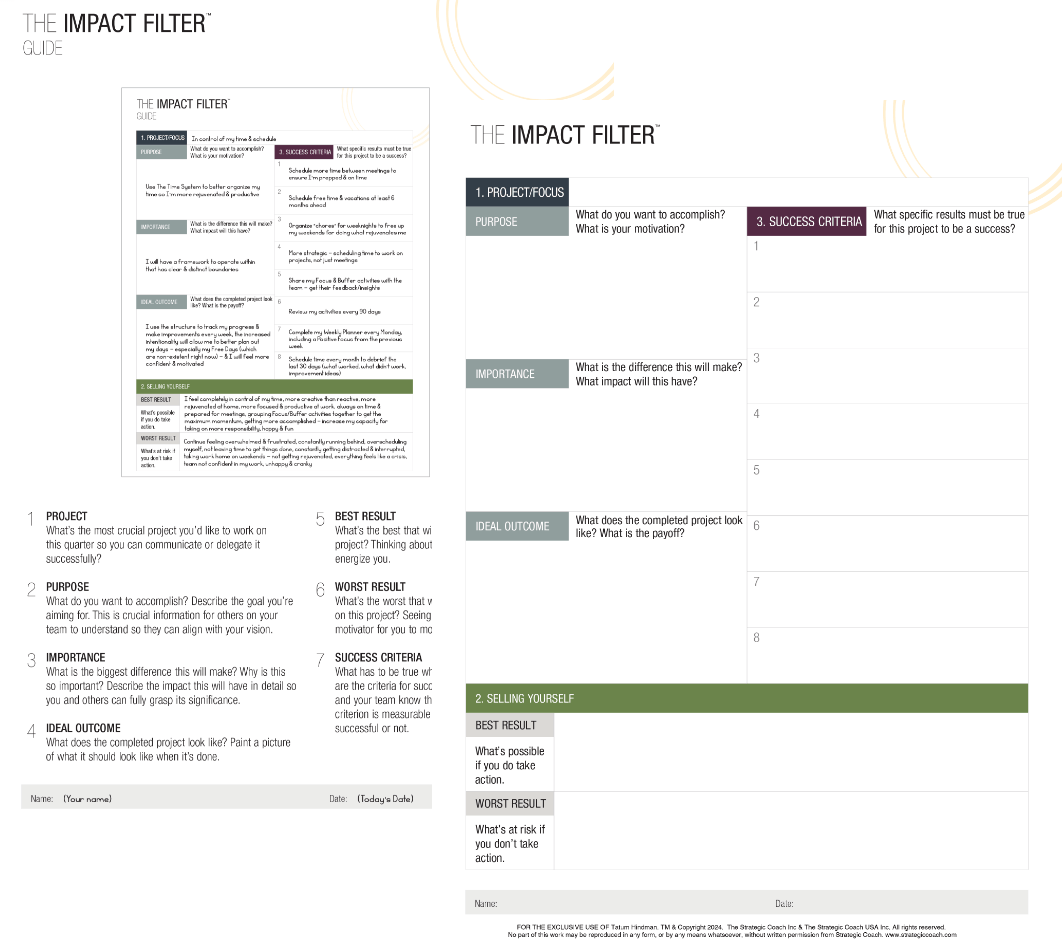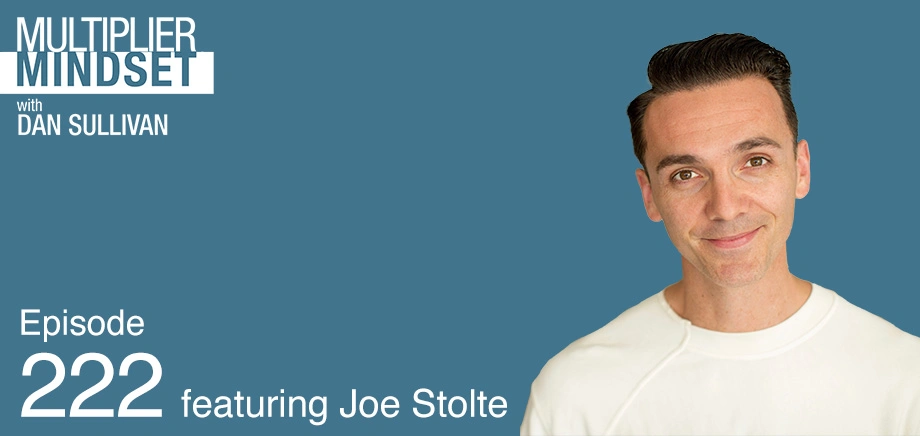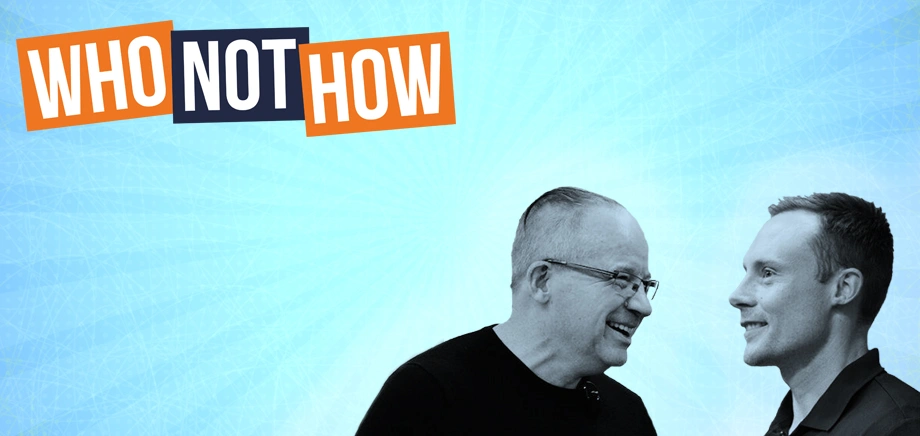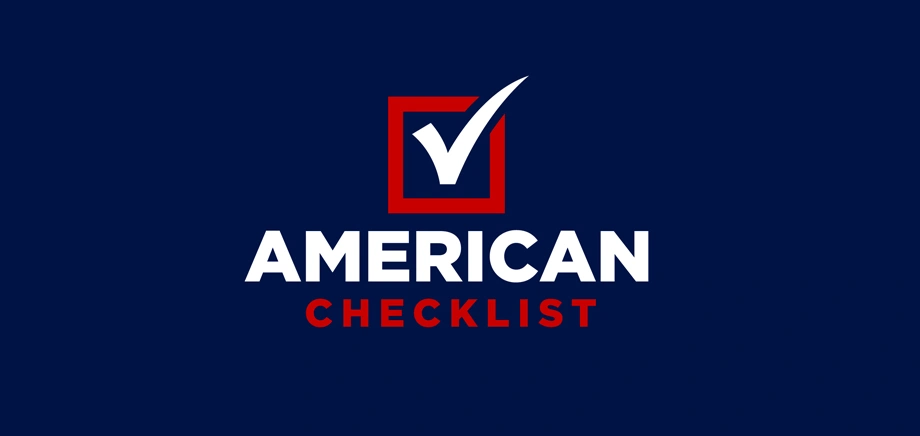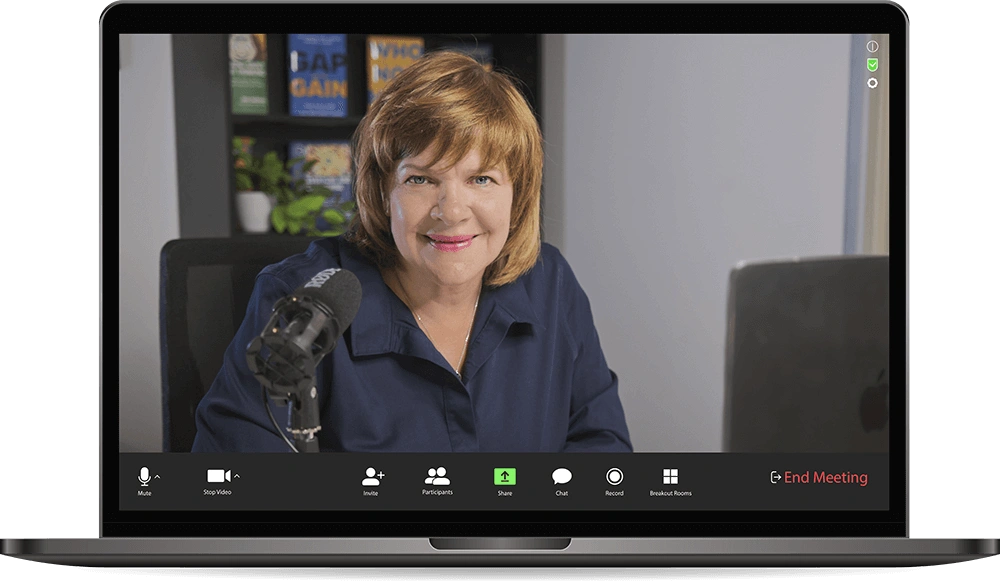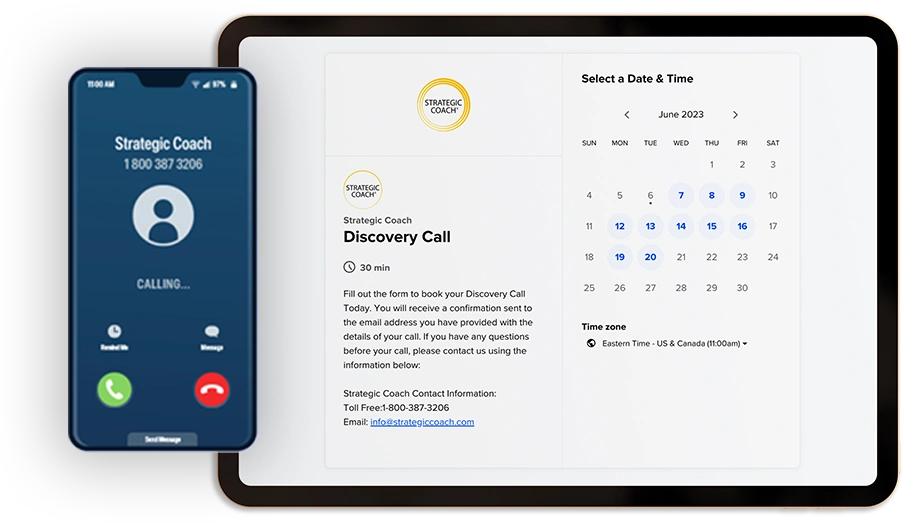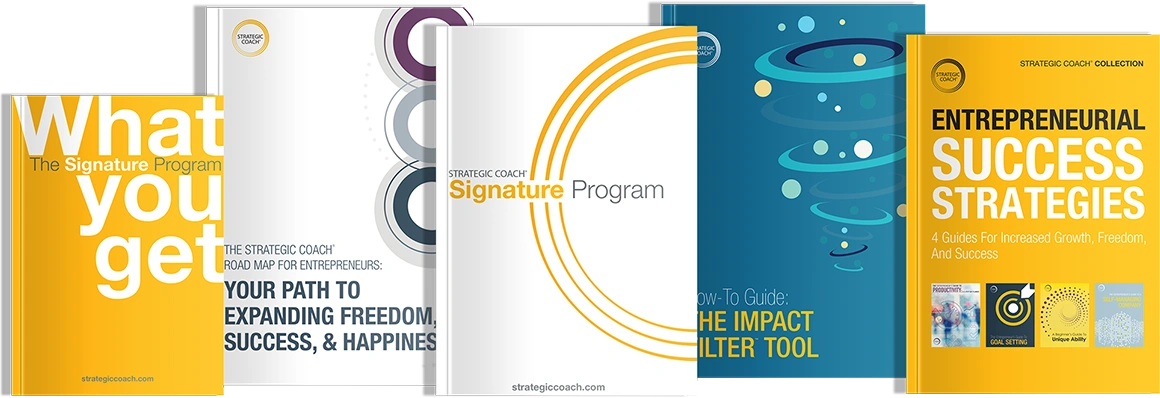AI Strategies To Empower Lifelong Entrepreneurs, with Joe Stolte
October 09, 2024
Hosted By
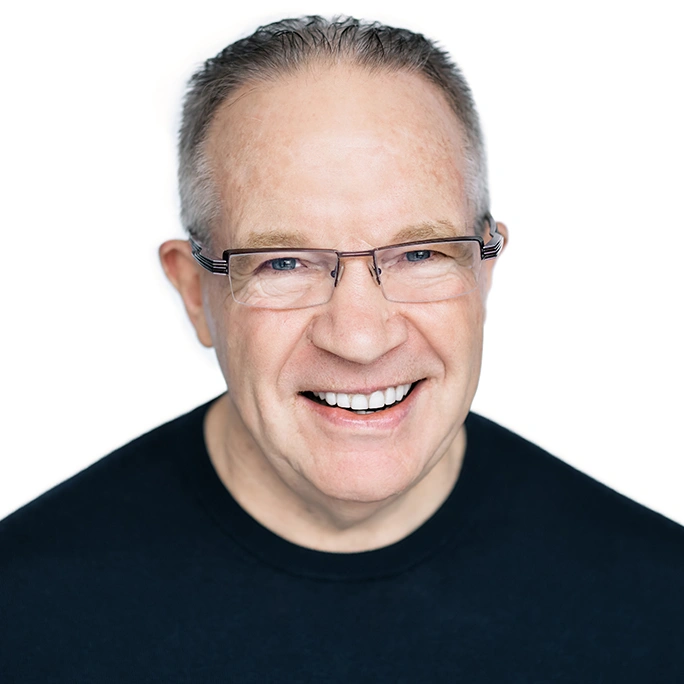 Dan Sullivan
Dan Sullivan
Joe Stolte is an entrepreneur working at the crosshairs of marketing and artificial intelligence. His company, Daily AI, uses machine learning to help thought leaders and small brands build AI-automated email newsletters. In this episode, he explains how his company supports clients in achieving business success and talks about the business lessons learned from his company’s early days.
Here's some of what you'll learn in this episode:
- The entrepreneur ideas and entrepreneur motivation Joe showed at a very young age.
- How Joe’s company finds the best content in the world on any topic clients choose.
- What it means to have short-term pessimism and long-term optimism.
- How the AI becomes smarter, making the newsletters better.
- The change in mentality that’s given Daily.ai an edge.
Show Notes:
When it seems everything out there is negative, what grabs your attention is the stuff that’s positive.
It’s a win-win to partner with people who already have a marketplace of your potential clients.
An entrepreneur doesn’t have to be the one with the idea.
If you focus only on customers that are a good fit for your company, they’ll refer you to other people.
ChatGPT has given people a taste of the exponential power behind machine learning and AI.
If you get your clients their desired outcomes, the outputs don’t really matter.
During tough times, you have to manage your expectations.
You know you always need to get better, even during good times.
Ads almost always get less than 50% conversion.
Anything in excess becomes its opposite.
Resources:
Who Not How by Dan Sullivan and Ben Hardy
Episode Transcript
Dan Sullivan: Hi. This is Dan Sullivan. I'd like to welcome you to the Multiplier Mindset Podcast. A real treat for me today because one of our Strategic Coach clients Joe Stolte, but not only that, but we're clients of his because he has a fascinating new thing, a new technological tool. And I heard him speak at Joe Polish's Genius Network, and before I go to any conference, I write out a Impact Filter of the things that I want to look for or be aware of while I'm in the conference. In that way, I'm not paying attention to everything, I'm only looking for certain things that I'm looking for. And after Joe spoke, I went up and I said, "Well, I had eight things I was looking for, and you just checked seven of the boxes." The thing I love about what Joe's doing with his AI newsletter concept is that we've often thought about having a regular newsletter, but it's just a lot of work, and it's not the main thing that we do.
It would be a lot of extra work. It isn't a moneymaking activity. It would be a newsletter to get interest in Coach, but more newsletters are like podcasts: you do it to establish a relationship with the marketplace, with like-minded people and they tell other like-minded people about it, and you start getting an audience. But I'd like to back up a little bit and go to what Joe said about his beginning comments of taking his lunch money and buying candy and then using the candy to purchase much higher quality food. Is this man and entrepreneur? Yep. Boy, is he an entrepreneur. Yep. There's like a fork in the road for children, and 19 out of 20 children, maybe it's 99 out of a hundred people, when they come to the fork in the road, they take the fork that leads them to lifetime employment. And there's one of them, maybe it's one of 20, who says, "No, I think I'm going to not do what other people do. I'm going to create my own business. I'm going to create something of my own where I'm not an employee, I'm the boss."
Joe Stolte: My past entrepreneurial journey, for the most part, I'm a fifth-time founder. I've had three exits, which means I've successfully sold three companies, and I'm very much the kind of prototypical serial entrepreneur. I love to take ideas when they're brand new or poorly developed, or in their infancy and then make them real, bring them to market, build teams, amass capital, scale them, and then eventually sell them or take them public. And it's interesting because I knew that I was always going to be an entrepreneur pretty early. The very first entrepreneurial thing that I did was... I grew up in the '80s and both my parents worked. In fact, my mom worked two jobs. My father was in the military, and instead of moving us around, he moved around a lot. And so at a very early age, especially by today's standards, I was walking myself to school, and my parents didn't have time to make me lunch, so they'd just give me money to buy lunch at school.
Well, I realized that the school lunch sucks pretty quickly, so what I would do in the morning at fourth or fifth grade, I would stop by the convenience store and I would buy all the best candy that I bought with all my lunch money. And then I would take the candy and I would trade the candy at school for the best lunch because other people's parents put a bunch of time into making lasagna or tacos, and so I could literally get the best of any of the food available in the cafeteria with my currency of candy. And then the next thing I did that was entrepreneurial as a kid is my father taught me how to mow the lawn, and I really did not like mowing the lawn, but I had saw... I grew up in a farm town of less than a thousand people outside of Portland, Oregon, so there wasn't a ton of opportunity.
The one thing that you could do is mow lawns for money, so I went around and knocked on doors and was like, "Hey, can I mow your lawn for $10?" And I think they were just shedding mercy on young 10- or 11-year-old Joe. But what I realized, I didn't like to mow the lawns. So because we lived in a small farm town, I had my friend that speaks Spanish, basically I asked some migrant workers if they would do it for me, if I'd paid them $5 per lawn. And then I borrowed some lawnmowers from friends, and they did. And I basically was able to make money without doing any of the actual fulfillment. Now, I didn't know that was a business at the time. I just wanted to buy cool clothes for school, and so I stopped, but that was my origin story.
And then in the middle, I went to college. I'd spent a couple of years in corporate America, and then one day I woke up and was like, "Wow, this is not really where I want to hang my hat. This isn't what I'm called to do," and I left and began my career as a serial founder. Today, I'm the CEO of a company called Daily.ai, and we use AI, specifically machine learning, to help thought leaders and small brands build AI-automated email newsletters. And so we were fortunate have to work with some really great thought leaders, everybody from my business partner in the business, Dr. Peter Diamandis, to Joe Polish and Chris Voss, and even Dan Sullivan. Recently, we helped Dan launch a newsletter called The Spark. And what's really unique about what we do in the marketplace is we actually use machine learning to go out and find the best content in the world on any topic that you choose, whether that's your topics that you have subject matter expertise on or other people's content.
Maybe you're not a top 1% thought leader in productivity, but you want to curate that content for your audience and give it to them, so that's what we do. We go out and we curate content. And then what's cool about that is the AI actually gets smarter based on how your audience opens and interacts with your newsletter, so the more that they open and click, the smarter the AI becomes and the better your newsletter gets both for you as well as for your subscribers, so we call that adaptive learning. And the third cool thing about what we do is everything is summarized in your voice, and that's done through generative AI, similar to tools like Chat GPT, although we have our own. And we really had Dan on our list of people that we really wanted to work with when we started launching the company and bringing it to market, so I had a chance to share this with him. We met each other at Joe Polish's 100K Mastermind. We're really excited. His newsletter is called The Spark, and it's one of my favorite newsletters.
It's definitely one of the most successful newsletters we've ever launched, and it's really only being launched now. The open rate continues to get better and better and better the more the AI learns Dan's audience. The click-through rate continues to get higher and higher as the AI starts to figure out what Dan's audience likes. So it's really exciting to be able to work with folks like Dan and Joe and Chris, but we also work with people that aren't thought leaders. We have over a hundred customers in 20 different industries, whether you're in services like registered investment advisors or real estate or insurance, or you're in tech companies, product companies, e-commerce companies. We even have the National Electricians of Association of Australia as a customer. So it's not just thought leaders; we just love our thought leaders because they help us spread the word about what we do.
So there definitely was many days that were challenging in our journey with Daily.ai, even with all the companies that we've created. I think one of the biggest challenges is when you're early, you don't know what you don't know. Ambiguity is at its highest. And so you really have to practice what my other business partner, Eben Pagan, calls having short-term pessimism and long-term optimism, which means test everything in the short term and assume it's not going to work. When you launch an ad, you don't get 100% conversion. It's almost always less than 50%, meaning most people don't click, they don't buy, they don't do the thing you want them to do. But by using data and just trying to find the next best step in the short term and assuming it's not always going to work out perfectly, A, I think you manage your expectations through those tough times. But B, if you can hold this, what seems like a contrasting view of having long-term optimism, it helps during those dark days when it's like, "Wow, why is nobody buying this week or this month? Or why did these customers churn or why do they want to leave?" In our early days, we didn't quite have what we call product market fit down. We didn't have the exact thing that we were building that was the exact hand-in-glove fit for the needs in the marketplace. And so in those early days, I used that mental model, having that short-term pessimism, used data, long-term optimism, and I think that gets us through the hard times, but it also tempers our optimism in the good times, meaning that we know we always need to get better.
We always need to listen to the marketplace, talk to our customers and help them solve their next best problem, or even look at the challenges that they can't see and start thinking about how we can create solutions for those. So we actually launched this company into the marketplace in 2021, and we did a beta program in 2022. Now, just as a reminder, before let's say October of 2022, the average person didn't care about AI or machine learning or generative AI. And then around, I think between Halloween and Thanksgiving, we all started seeing these images on our social media of all of our friends looking like astronauts or futuristic superheroes and these artistic drawings. Well, that was an app called Lensa, and then also right after that Chat GPT launch, and it was one of the fastest growing digital products in the history of our species, and so now all of a sudden people got a real taste of the exponential power behind machine learning and AI.
Well, prior to that, I would tell people about what we're doing with AI, and they didn't have any receptor cells in their brain to receive the ideas and understand the significance of them. So for the first nine months in 2022, it sounded cool, but if you weren't a bleeding-edge early adopter, a lot of the value that we're bringing to the table, A, we weren't doing a very good job translating that, and so I could just feel people rolling their eyes in their head as I would talk about these concepts, and that got much, much easier after AI became what it is today. But it was really great because even though those times were really hard, we really wrestled with, "How can we take an AI output and make this a meaningful outcome for our customers?" And so when we saw a lot of new AI tools coming into the marketplace, they were really focused on outputs. And so one of the mantras in our companies is outcome over outputs—get our customers the outcome.
It doesn't really matter about the output because, for example, we can go into an AI tool like Midjourney or DALL-E 2 or Chat GPT, we can type a prompt and we can get an output almost instantly. And it's so mind-blowing the novelty and dopamine you get from that experience. It's really, truly cool. It's also as cool to watch Netflix and watch a really good movie. They'll have about the same impact on your business in terms of the outcomes if you don't test it. So if I take that output and I don't ask myself, "Hey, did that move the needle in my business? Did that get the click, the open, the intended objective?"
And if it didn't, then it's literally about as cool as watching Netflix from a "the way you feel" perspective. And so those hard times really taught us, "Let's build things into our product that get our customers measurable outcomes that are going to move the needle in their business." And I think that mentality has really helped give us an edge now as there's a whole bunch of new AI tools. One of the biggest impacts that we don't always talk about publicly is that our secret agenda is actually help people think more abundantly. So one of the course of our technology is something called the perspective engine, and what this does is when we go out and look at hundreds of thousands of different articles every day, our perspective engine is actually filtering out negative news and clickbait and things that are really designed to put you in a fear state, to trigger your parasympathetic nervous system.
In the news, they say, "If it bleeds, it leads." What we say is, "Anything at its excess becomes its opposite." And when everything out there is negative, what actually grabs your attention is the stuff that's positive, the stuff that actually helps you think more abundantly to build those positive neurosynaptic connections in your mind. So we don't even advertise this as a benefit, but what comes with our service, batteries included, is that you're going to get what we call future-forward positive content. And the reason why that's cool is because it gives the subscribers of our customers something that we call "hopamine." It's like hope and novelty and dopamine all mixed together, and that's our secret sauce. So that's I think, the biggest impact that we've made. That's our big, broader mission with the company, is to help maybe transform a billion minds through positive content over time.
This is our first year really being in the marketplace where anybody can buy our product. And so for us this year, it's really two things. Number one, it's finding really, really good partners who already have a marketplace of our potential customers where it's a win-win for us to partner with them. And so almost always that looks like the partner buys our service, they get a lot of value out of it, and then we go to market together to propagate what we do to their marketplace. That's been really powerful for helping getting the right people on our platform and really letting the world know what we're up to. And I think the second thing from there is we're really focused on 10x growth. And so we're really trying to 10x the growth or the revenue that we had last year by the end of next year, and that's really our focus. But it's really measured and controlled 10x growth, if that makes sense.
Meaning we really only want good-fit customers that are really getting a 10 out of a 10 experience so they can refer us to everyone they know, love, and trust, so that's really what we're focused on in the future. I think the big advice that I might have to other entrepreneurs, maybe even myself from 10 years ago, is that, number one, you don't always have to have the idea. I think sometimes as entrepreneurs who like to own the fact that we're really good at generating a lot of ideas, but if you look at the number of ideas that need to come into the marketplace of thought, there needs to be a lot of ideas even to take an initial idea and make it great or make it real in the marketplace, so you don't have to come up with a great idea. One of my business partners in this business is Dr. Peter Diamandis.
Peter's just an extraordinary thinker and he has an extraordinary mind, and he thinks about things in a very different way. And so this initial concept actually came from our other business partner, Eben Pagan, and was really accelerated by Peter, and when you put their two minds together, it was really something special. And then myself and the rest of our team was able to come along and make that real in the marketplace and contribute our ideas in a way that brings it to market and makes it great. And so that would be my thought is, who can you partner with even at the earliest stages that might even have a different way of thinking? They're entrepreneurs that think in a different way, and then how can you take those ideas and accelerate them, make them real, actualize them in the marketplace? Many just say that because I meet a lot of entrepreneurs and even myself when I was younger and I really wanted it to be my idea or my thing, or I was so in love with my ideas that I couldn't see the brilliance of what other people brought to the table.
And so therefore, now that I'm in this position, I wouldn't even be able to be the CEO of this company if I didn't have that lesson. That I have to say, this is my fifth company and I'm having the most fun of any company that I've ever ran or been the CEO of in my life that I wouldn't have had that opportunity if I didn't learn that lesson as part of my journey. The reason why I joined Strategic Coach is, I have a fascination with something that I call Prime Minds. They're like prime numbers. If you follow really good ideas to their core, to the point where they're not indivisible anymore, you can't divide them further, you end up coming back to the same 80/20 minds. And if you disaggregate those even further, you'll end up looking at things like Plato and Socrates and stuff that's less relevant today.
But the reason why I joined Strategic Coach is because I see Dan Sullivan as a Prime Mind. A lot of the really good ideas that I've learned from other entrepreneurs, other thought leaders, other coaches I've had, they've all actually been through Coach and they got those ideas from Dan or from the program. And so I just felt like with this company that we're launching now, it was the absolute best move for me is to join Coach and go ahead and close my gap between what I know about the Program and how I'm implementing that in my life, and also to just get closer to these concepts that I know Dan and the whole team at Coach has put together and try to bring them to our business, to our team, to our customers, and have as much fun as we can this time.
Dan Sullivan: I just love his whole "hopamine," not dopamine, but "hopamine." I think he should get the copyright on that trademark, and if he can bottle it and sell it, I think he'll be a billionaire. But the whole experience that I see with Joe is just extraordinary. And the real insight I got from what he's doing is that I think the AI newsletter that we have, The Spark, is actually going to, more and more, tell us what we should be doing with all of our marketing, just how it develops and what it tells you about what people like in the marketplace. It's a real treat just to hear Joe tell his story. He's fun to talk with, and I know Eben Pagan and I know Peter Diamandis, two of his business partners, so it's great company he's keeping, and I'm really pleased that he wanted us to be part of his project.
Related Content
The Impact Filter
Dan Sullivan’s #1 Thinking Tool
Are you tired of feeling overwhelmed by your goals? The Impact Filter™ is a powerful planning tool that can help you find clarity and focus. It’s a thinking process that filters out everything except the impact you want to have, and it’s the same tool that Dan Sullivan uses in every meeting.
